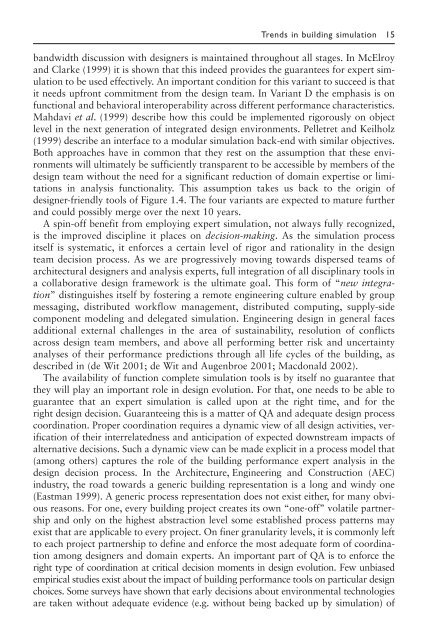Advanced Building Simulation
Advanced Building Simulation
Advanced Building Simulation
You also want an ePaper? Increase the reach of your titles
YUMPU automatically turns print PDFs into web optimized ePapers that Google loves.
Trends in building simulation 15<br />
bandwidth discussion with designers is maintained throughout all stages. In McElroy<br />
and Clarke (1999) it is shown that this indeed provides the guarantees for expert simulation<br />
to be used effectively. An important condition for this variant to succeed is that<br />
it needs upfront commitment from the design team. In Variant D the emphasis is on<br />
functional and behavioral interoperability across different performance characteristics.<br />
Mahdavi et al. (1999) describe how this could be implemented rigorously on object<br />
level in the next generation of integrated design environments. Pelletret and Keilholz<br />
(1999) describe an interface to a modular simulation back-end with similar objectives.<br />
Both approaches have in common that they rest on the assumption that these environments<br />
will ultimately be sufficiently transparent to be accessible by members of the<br />
design team without the need for a significant reduction of domain expertise or limitations<br />
in analysis functionality. This assumption takes us back to the origin of<br />
designer-friendly tools of Figure 1.4. The four variants are expected to mature further<br />
and could possibly merge over the next 10 years.<br />
A spin-off benefit from employing expert simulation, not always fully recognized,<br />
is the improved discipline it places on decision-making. As the simulation process<br />
itself is systematic, it enforces a certain level of rigor and rationality in the design<br />
team decision process. As we are progressively moving towards dispersed teams of<br />
architectural designers and analysis experts, full integration of all disciplinary tools in<br />
a collaborative design framework is the ultimate goal. This form of “new integration”<br />
distinguishes itself by fostering a remote engineering culture enabled by group<br />
messaging, distributed workflow management, distributed computing, supply-side<br />
component modeling and delegated simulation. Engineering design in general faces<br />
additional external challenges in the area of sustainability, resolution of conflicts<br />
across design team members, and above all performing better risk and uncertainty<br />
analyses of their performance predictions through all life cycles of the building, as<br />
described in (de Wit 2001; de Wit and Augenbroe 2001; Macdonald 2002).<br />
The availability of function complete simulation tools is by itself no guarantee that<br />
they will play an important role in design evolution. For that, one needs to be able to<br />
guarantee that an expert simulation is called upon at the right time, and for the<br />
right design decision. Guaranteeing this is a matter of QA and adequate design process<br />
coordination. Proper coordination requires a dynamic view of all design activities, verification<br />
of their interrelatedness and anticipation of expected downstream impacts of<br />
alternative decisions. Such a dynamic view can be made explicit in a process model that<br />
(among others) captures the role of the building performance expert analysis in the<br />
design decision process. In the Architecture, Engineering and Construction (AEC)<br />
industry, the road towards a generic building representation is a long and windy one<br />
(Eastman 1999). A generic process representation does not exist either, for many obvious<br />
reasons. For one, every building project creates its own “one-off” volatile partnership<br />
and only on the highest abstraction level some established process patterns may<br />
exist that are applicable to every project. On finer granularity levels, it is commonly left<br />
to each project partnership to define and enforce the most adequate form of coordination<br />
among designers and domain experts. An important part of QA is to enforce the<br />
right type of coordination at critical decision moments in design evolution. Few unbiased<br />
empirical studies exist about the impact of building performance tools on particular design<br />
choices. Some surveys have shown that early decisions about environmental technologies<br />
are taken without adequate evidence (e.g. without being backed up by simulation) of

















